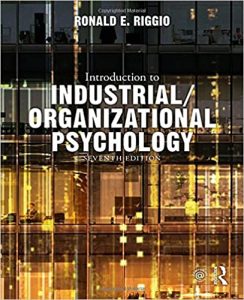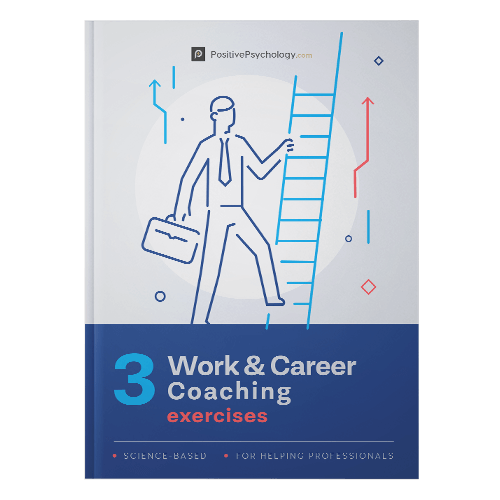What Is Industrial Psychology? 10 Examples and Theories
 Many of us spend over 80,000 hours in our careers (80,000 Hours, n.d.).
Many of us spend over 80,000 hours in our careers (80,000 Hours, n.d.).
With such an enormous chunk of our lives dedicated to working, we must learn to use that time wisely.
Industrial psychology can help; it examines our identity and behavior in the work environment by asking key questions (Riggio, 2017):
How can we redesign a job to make it more efficient and engaging?
What makes some roles so stressful?
What makes someone a good manager?
This article explores what we mean by industrial psychology, the theories behind it, and how we apply them in the workplace.
Before you continue, we thought you might like to download our three Work & Career Coaching Exercises for free. These detailed, science-based exercises will help you or your clients identify opportunities for professional growth and create a more meaningful career.
This Article Contains:
- What Is Industrial Psychology?
- 4 Real-Life Examples of Industrial Psychologists
- 6 Theories of Industrial Psychology
- Applying Industrial Psychology in the Workplace
- 6 Masters Degrees, Courses, and Training Options
- Fascinating Industrial Psychology Books
- Resources From PositivePsychology.com
- A Take-Home Message
- References
What Is Industrial Psychology?
‘Wouldn’t it be wonderful if all employees loved their jobs so much that they couldn’t wait to get to work? And what if staff were so well suited to their role that their performances were outstanding?’ (Aamodt, 2010).
The answer is obvious: yes. While it may be unlikely to happen all the time and for everyone, a happy and productive workforce is the ultimate goal of industrial psychology (Aamodt, 2010).
Industrial psychology focuses on areas of employment and organizational processes that create an environment for success, including (Rogelberg, 2007):
- Team and organizational effectiveness
- Employee recruitment and promotion
- Individual differences, measurement, and testing
- Training and development (including coaching)
- Performance management (appraisal and improvement)
- Workplace health (stress and safety)
- Employee attitudes and satisfaction
- Compensation and benefits
- Employee motivation
- Employee harassment and bullying
What do industrial psychologists do?
Industrial psychologists apply the theories and principles of psychology to the workplace in an attempt to “enhance the dignity and performance of human beings, and the organizations they work in, by advancing the science and knowledge of human behavior” (Rucci, 2008, p. 17).
In turn, a practitioner adopts various principles and theories, including (Aamodt, 2010):
- Social learning theory to build training and development programs and incentive plans
- Social psychology to create working groups to understand and reduce employee conflict
- Motivational and emotional theories to meet the psychological needs of employees and increase their satisfaction at work
While industrial psychologists are engaged in areas similar to human resource managers, they often differ in techniques and rationale. For example, industrial psychologists rely on psychological testing, behavioral interviews, and work data. On the other hand, human resources departments typically adopt unstructured interviews to progress staff selection and promotion (Aamodt, 2010).
Industrial vs organizational psychology
Most texts combine or alternate between the terms industrial and organizational psychology and offer no distinction (Aamodt, 2010; Rogelberg, 2007; Riggio, 2017).
However, the two overlapping terms do indeed differ, albeit slightly. While industrial psychology focuses on the people at work, often exploring individual differences and their effect on performance, organizational psychology attempts to understand their role in the organization and its function in society (Samiksha, n.d.).
In this article, we use the two terms synonymously.
A brief history of the field
Early in the 20th century, when the field of psychology was still very new, a few psychologists turned their attention to work behavior. Prior to the First World War, Hugo Munsterberg began working on improving staff selection for streetcar operators. At the same time, Walter Dill Scott, a pioneer of industrial psychology, studied salespersons and the psychology of advertising (Riggio, 2017).
Frederick Taylor, an engineer, suggested using science to understand work behavior. He became the founder of the scientific management movement and the originator of time-and-motion studies, successfully improving the efficiency of many manual roles and tasks.
However, more complex, modern tasks are less suited to the approach, as they can be performed in multiple ways depending on the context and desired outcome, such as computer coding, marketing, or design (Riggio, 2017).
It wasn’t until after the Second World War that industrial psychology received more widespread attention, pushed along by legislation changes, such as the Civil Rights Act of 1964.
By the 2000s, the most significant change to employees and industrial psychologists was the rapid rise and advances in technology, particularly the speed and volume of communication and the ability to connect with anyone worldwide instantly (Aamodt, 2010).
Today, “industrial/organizational psychology is one of the fastest growing areas of psychology” (Riggio, 2017, p. 13).
4 Real-Life Examples of Industrial Psychologists
 Because industrial psychologists do so many things, it can be challenging to provide a complete definition of their typical role across all settings.
Because industrial psychologists do so many things, it can be challenging to provide a complete definition of their typical role across all settings.
With predicted employment in this field set to increase dramatically, we find industrial psychologists in some of the world’s largest companies, including (Riggio, 2017):
- Ford Motor Company
- Disney
- Pepsi
- Toyota
- Xerox Corporation
- United Airlines
Examples of roles include the following (Riggio, 2017):
- Dr. C began his career by assessing employee work satisfaction for a telecommunications company before joining a large consulting firm to conduct and analyze staff surveys and manage organizational development programs.
- Having worked for a large consulting firm, Dr. R now runs his own practice specializing in personnel selection and recruitment, marketing, and attitude surveys, and is an expert witness in labor-related legal cases.
- Dr. O is an assistant director for a chain of fast-food restaurants, researching new locations and organizing customer satisfaction surveys.
- Mr. K is director of human resources for a biomedical company and oversees benefits, compensation, and employee selection, and sets up special human resource programs for his employees.
While it is impossible to talk about the typical role of industrial psychologists, their work remains underpinned by psychology’s theory, practice, and principles.
6 Theories of Industrial Psychology
Industrial psychology uses a broad range of psychological theories to better understand employees, organizations, and their interactions (Aamodt, 2010).
Below, we look at a selection of theories that apply to the field of industrial psychology regarding motivation and employee satisfaction.
Employee motivation
“Psychologists have postulated that some employees are more predisposed to being motivated than are others” (Aamodt, 2010, p. 328). In other words, some staff will always be more motivated than others, despite either recognition or reward.
Here is a small sample of theories commonly applied in industrial psychology:
- Self-regulation theory
This theory suggests that “employees monitor their own progress toward attaining goals and then make the necessary adjustments; that is, they self-regulate” (Aamodt, 2010, p. 342) - Expectancy theory
“The individual chooses to behave in accordance with the alternative that she or he associates with the highest subjective expected utility” (Rogelberg, 2007, p. 235). The possible outcomes of behavior are factored against the probability of a particular performance level, and the higher the score, the greater the employee’s motivation. - Equity theory
Focuses on the causes and consequences of individuals’ perceived fairness in relationships with others. It suggests our job satisfaction and motivation are related to how well we believe we are being treated compared with others (Rogelberg, 2007; Aamodt, 2010).
There are other theories, and most likely, an employee’s current level of motivation is best understood through an integrated view.
Job satisfaction
Organizational commitment and job satisfaction have been widely studied in organizational psychology and appear highly correlated. Both are important to the employee and the employer as they affect commitment to the job and the organization, including attendance and positive behavior at work (Aamodt, 2010).
Several theories focus on the factors involved in job satisfaction, including:
- Individual difference theory
This theory suggests that “some variability in job satisfaction is due to an individual’s personal tendency across situations to enjoy what she does” (Aamodt, 2010, p. 367). Therefore, for some, roles don’t matter; every task motivates and satisfies them. - Discrepancy theory
Job satisfaction requires certain employee values, expectations, and needs to be met. When not addressed, employee satisfaction suffers. - Social learning theory
The social learning theory suggests that employees observe the degree of happiness of those nearby and then model them.
Industrial psychology is fascinating because it impacts us all in a significant area of our lives; work. And, as such, it includes theories and practices taken across multiple fields of psychology.
Applying Industrial Psychology in the Workplace
 The following areas are crucial to the success and wellbeing of the individual and the organization.
The following areas are crucial to the success and wellbeing of the individual and the organization.
As a result, they receive considerable focus from industrial psychologists in the workplace.
Human resource planning
“The best organizations continually evaluate their human resource needs and plan their hiring and staffing in order to meet their companies’ business goals.”
Riggio, 2017, p. 92
Human resource professionals and the field of industrial psychology need to focus on the following closely related processes (Riggio, 2017):
- Talent inventory
Assessing employees’ knowledge, skills, abilities, and how they are used - Workforce forecasting
Planning future organizational requirements, including volume and skill sets - Control and evaluation
Constantly evaluating the effectiveness of industrial psychology programs and interventions
Employee recruitment requires an understanding of the nature of the job and the critical employee characteristics needed. Getting the right candidate for the job increases job performance and reduces staff turnover.
Performance appraisal
Employees’ performance must be continuously monitored. Early results provide helpful feedback for the recruitment process and, over time, identify needs and opportunities for training and development (Riggio, 2017).
Job performance is measured against criteria used to assess successful or unsuccessful performance levels: objective performance criteria (such as the number of units made or products sold) and subjective performance criteria (judgments or ratings of other employees, including their manager).
Organization development
Industrial psychology focuses its attention on organizational development with the aim of understanding and helping an organization change, managing and avoiding layoffs, and recognizing the importance of employee culture (Aamodt, 2010).
Managing and providing input to the most appropriate (and necessary) organization-wide transformation can improve performance. Such change may arise out of governmental regulations or external market pressures.
Positive changes can arise from an organization looking at its own practices and policies and asking questions, such as:
Why are we doing this?
Does it add value, increase productivity, or improve customer service?
Can it be done better by another team, individual, or even outsourced?
Ultimately, the correct change performed at an appropriate time and considering the employee, customer, and organization can have far-reaching benefits, yet it must be handled carefully.
How to become an industrial psychologist – Careers24
6 Masters Degrees, Courses, and Training Options
There are plenty of study options available to begin or develop as an industrial psychologist. Take time and care to find the most appropriate for the career you wish to pursue.
8 Requirements of industrial psychologists
Many industrial psychologist positions within businesses require a master’s degree, while academic teaching positions in colleges and universities typically expect a doctorate.
Hard skills required to be an industrial/organizational psychologist include (Brogaard, 2021):
- Analytical skills
- Problem-solving abilities
- Research skills
- Administrative skills
Soft skills include:
- Interpersonal skills
- Conflict management
- Communication skills
- Teamwork abilities
3 Degree programs to consider
Many of the routes to becoming an industrial/organizational psychologist involve a bachelor’s degree in psychology before completing a master’s degree in industrial/organizational psychology.
Examples include the following:
Master’s degree (MA) in Industrial/Organizational Psychology, University of New Haven, Connecticut, U.S.
 This master’s degree program offers students the opportunity to bring psychological principles to the workplace that benefit both employers and employees.
This master’s degree program offers students the opportunity to bring psychological principles to the workplace that benefit both employers and employees.
This flexible course curriculum provides opportunities for research and internship.
Find out more on their website.
Master’s degree (MSc) in Organizational Psychology, UNICAF University, Malawi/Zambia/Uganda/Zimbabwe
 This program may be particularly valuable for working professionals in larger organizations who wish to understand the effect of human interaction on the working environment.
This program may be particularly valuable for working professionals in larger organizations who wish to understand the effect of human interaction on the working environment.
The master’s degree is taught with real-world application in mind and focuses on how to understand the organization’s human resources.
Find out more on their website.
Master’s degree (MS) in Human Factors and Industrial/Organizational Psychology, Wright State University, Ohio, U.S.
 Including a thesis and non-thesis option, this master’s degree explores how to improve group performance and systems through psychology.
Including a thesis and non-thesis option, this master’s degree explores how to improve group performance and systems through psychology.
With a range of audio-visual equipment, observation rooms, and 20,000 square feet dedicated to psychological research, this is a well-equipped campus.
Find out more on their website.
3 Best Online Courses
Many educational institutes offer advanced training in industrial psychology online, including:
Master’s degree (MA) in Industrial/Organizational Psychology, George Mason University, Virginia, U.S.
 This online master’s degree trains students to apply psychological research in the work setting.
This online master’s degree trains students to apply psychological research in the work setting.
Focus areas include personnel selection, quantitative analysis, organizational health, leadership, and work and family issues.
Find out more on their website.
Master of Applied Industrial/Organizational Psychology (MAIOP), Colorado State University, Colorado, U.S.
 Learn about how the study of human behavior in the work setting can improve performance and productivity.
Learn about how the study of human behavior in the work setting can improve performance and productivity.
Particular areas of interest include improving the quality of work environments, analyzing the effectiveness of workplace programs, and identifying training and development needs.
Find out more on their website.
Master’s degree (MS) in Industrial/Organizational Psychology, Bellevue University, Nebraska, U.S.
 Tailored to meet the demands of busy students with other work and family commitments, this 100%-online master’s degree emphasizes real-world organizational projects and statistical and analytical tools to ensure you bring a thoughtful, strategic approach to the field.
Tailored to meet the demands of busy students with other work and family commitments, this 100%-online master’s degree emphasizes real-world organizational projects and statistical and analytical tools to ensure you bring a thoughtful, strategic approach to the field.
Find out more on their website.
Fascinating Industrial Psychology Books
The following books all provide insights into industrial psychology that are helpful and practical for anyone interested in learning more about this fascinating discipline:
Industrial/Organizational Psychology: An Applied Approach – Michael Aamodt
 Now in its eighth edition, this popular book uses an applied approach to helping readers understand industrial/organizational psychology in everyday life.
Now in its eighth edition, this popular book uses an applied approach to helping readers understand industrial/organizational psychology in everyday life.
This readable book includes theory, case studies, and numerous diagrams to aid understanding of complex topics.
Find the book on Amazon.
Work in the 21st Century: An Introduction to Industrial and Organizational Psychology – Jeffrey Conte and Frank Landy
 This sixth edition text contains the latest research and themes, including diversity, personality, technology, and multicultural issues.
This sixth edition text contains the latest research and themes, including diversity, personality, technology, and multicultural issues.
Including many color photographs and explanatory diagrams, this is a must for both students and professionals wishing to learn more about this fascinating field.
Find the book on Amazon.
Introduction to Industrial and Organizational Psychology – Ronald Riggio
 This latest version of this classic text on industrial and organizational psychology achieves an excellent balance between science and application.
This latest version of this classic text on industrial and organizational psychology achieves an excellent balance between science and application.
This concise yet thorough evidence-based text provides essential communication to undergraduates and beyond.
Find the book on Amazon.
Resources From PositivePsychology.com
We have many resources throughout our website to help professionals in the field of industrial psychology.
To help, check out the following free worksheets and exercises:
- Social Problem Solving: Step by Step
This worksheet is a useful tool to help an individual or team define a problem, generate multiple possible solutions, and then select and evaluate the best solution to enact. - Workplace Strength Cards
This set of cards can be used as part of an icebreaker or team exercise to help workers identify their strengths and times they use them in their work. For more on using these cards, check out our dedicated article – Printable Strength Cards for Therapists and Coaches. - Stress Decision Framework
This worksheet helps organizational decision-makers put decision-making in context, illustrating that it is usually best to aim for good enough decisions, not perfect ones. - Workplace Mindfulness
This set of questions helps workers adopt a state of loving-kindness to themselves and others, helping to decrease stress and improve workplace satisfaction.
A Take-Home Message
A successful business requires an appropriate focus on both the organization and its employees. It is crucial to find the best people for the right jobs and then empower them to perform well through appropriate training and development (Riggio, 2017).
Understanding what motivates people to work, how to manage stress arising from job demands, and why employees behave as they do can help produce a happy and productive workforce (Aamodt, 2010).
The many and varied focuses and roles held by industrial psychologists make for a fascinating and broad field of study for either existing professionals or students considering their career options. Whether engaged in workforce forecasting or evaluating existing programs and interventions, the opportunity to support growth and change within an organization is extensive.
Use this article to introduce yourself to some of the background, real-life examples, and theories behind industrial psychology. And consider your role in helping people become better equipped for the challenges and opportunities they face across their working lives.
We hope you enjoyed reading this article. Don’t forget to download our three Work & Career Coaching Exercises for free.
- 80,000 Hours. (n.d.). 80000hours.org. Retrieved September 24, 2021, from https://80000hours.org/
- Aamodt, M. G. (2010). Applied industrial/organizational psychology. Thomson/Wadsworth.
- Aamodt, M. G. (2015). Industrial/organizational psychology: An applied approach (8th ed.). Cengage Learning.
- Brogaard, B. (2021, October 13). How to become an I-O psychologist. Retrieved September 27, 2021, from https://www.psychology.org/careers/industrial-organizational-psychologist/
- Conte, J. M., & Landy, F. J. (2019). Work in the 21st century: An introduction to industrial and organizational psychology (6th ed.). Wiley.
- Riggio, R. (2017). Introduction to industrial and organizational psychology (7th ed.). Routledge.
- Rogelberg, S. G. (2007). Encyclopedia of industrial and organizational psychology. SAGE.
- Rucci, A. J. (2008). I-O psychology’s “core purpose”: Where science and practice meet. The Industrial-Organizational Psychologist, 46(1), 17–34.
- Samiksha, S. (n.d.). Difference between industrial psychology and organizational psychology. Retrieved September 24, 2021, from https://www.yourarticlelibrary.com/industrial-psychology/difference-between-industrial-psychology-and-organizational-psychology/29497
Let us know your thoughts
Read other articles by their category
- Body & Brain (50)
- Coaching & Application (57)
- Compassion (26)
- Counseling (51)
- Emotional Intelligence (24)
- Gratitude (18)
- Grief & Bereavement (21)
- Happiness & SWB (40)
- Meaning & Values (26)
- Meditation (20)
- Mindfulness (45)
- Motivation & Goals (45)
- Optimism & Mindset (34)
- Positive CBT (29)
- Positive Communication (20)
- Positive Education (47)
- Positive Emotions (32)
- Positive Leadership (18)
- Positive Parenting (4)
- Positive Psychology (33)
- Positive Workplace (37)
- Productivity (17)
- Relationships (46)
- Resilience & Coping (37)
- Self Awareness (21)
- Self Esteem (38)
- Strengths & Virtues (32)
- Stress & Burnout Prevention (34)
- Theory & Books (46)
- Therapy Exercises (37)
- Types of Therapy (64)





What our readers think
This article has provided instructive insight relating to Industrial and Organizational Psychology. This is a course which I would like to pursue sometime in the future, God willing.
This course is very interesting and motivated. It plays a very big role in the world largest company as an industrial psychologist.
It makes to understand what motivates people to work, how to manage stress arising from job demands, and why employees behave as they do can help produce a happy and productive workplace.
The information was helpful to me..
Very well presented with Introductory of work place environment and its employees. I’m very interested in finding solutions to manage unproductive employees and design a happier workplace.